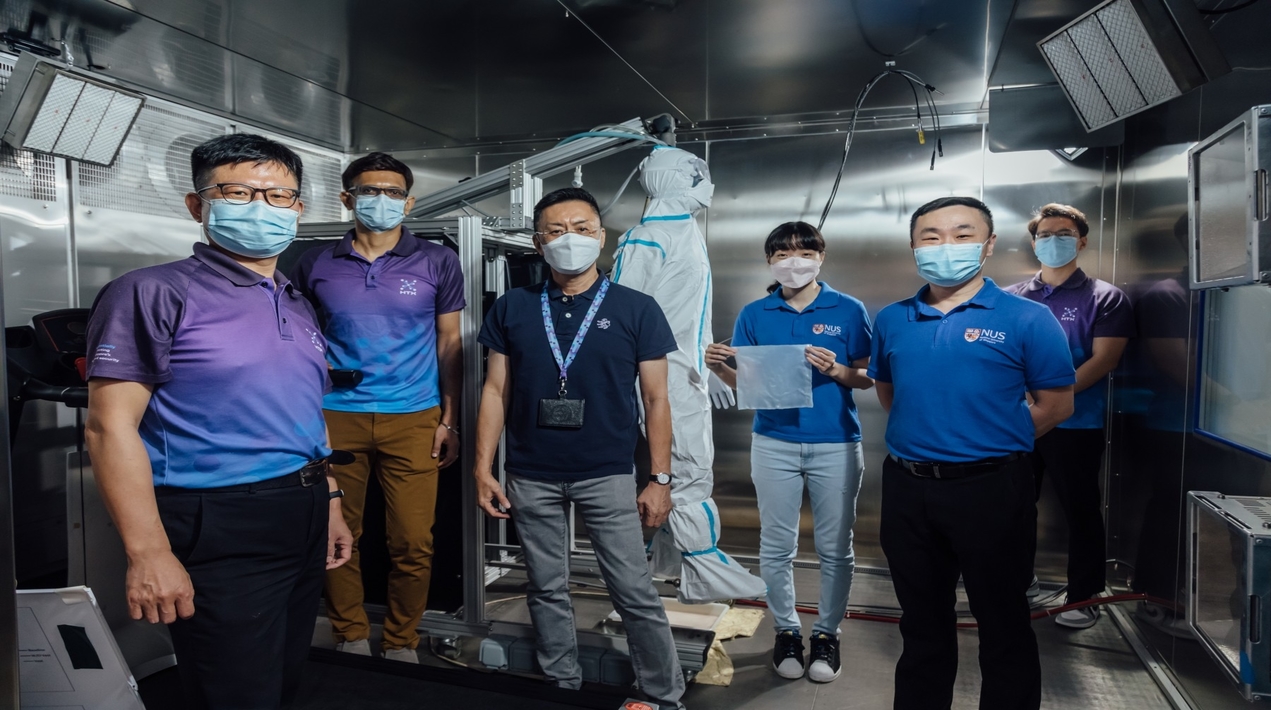
A team of researchers from the National University of Singapore (NUS) has developed a novel super-hygroscopic material that enhances sweat evaporation within a personal protective suit, to create a cooling effect for better thermal comfort for users such as healthcare workers and other frontline officers. The technology was validated via laboratory tests conducted in collaboration with researchers from HTX (Home Team Science & Technology Agency) in Singapore.
The new desiccant film technology, which is biocompatible and non-toxic, has a rapid absorption rate, high absorption capacity and excellent mechanical properties. This means that the material is very robust and durable for practical applications such as for protective suits worn by healthcare workers. It is also affordable, light-weight, easy to fabricate and reusable.
Attaching a piece of novel composite film in a protective suit – for example at the back of the suit – could bring down the heat index by about 40%, remarkably lowering the likelihood of heatstroke. This invention was published in Small on 20 February 2022.
By combining the NUS team’s scientific knowledge of advanced hydrogel materials and HTX’s deep understanding of the Home Team’s needs and engineering capabilities, the joint research team was able to customise and optimise the novel moisture-trapping material for practical applications to enhance the performance and productivity of frontline officers.
Cooling down by increasing sweat evaporation
Medical protective suits have excellent anti-bacterial and water-proof properties. However, this high level of protection stops the venting of water vapour produced by evaporated sweat and impedes heat loss from the body. This is why users such as healthcare workers who must wear protective suits for long hours, especially in tropical environments, often report occupational heat strain.
Thermal management solutions such as air-cooling garments with electrical fans or ingestion of ice slurry are impractical due to limitations such as bulkiness, heavyweight, and limited effectiveness. While advanced textiles and coatings are promising solutions, they are difficult to fabricate and production costs are high.
The NUS team came up with a practical strategy to overcome the current challenges by leveraging the principle of evaporative cooling. Their solution involves using a super-hygroscopic composite film to control the humidity level in the micro-environment in the protective suit.
When the moisture-trapping composite film absorbs water vapour within the protective suit, the humidity level drops. This in turn speeds up sweat evaporation from the skin. As a result, more heat is dissipated from the human body through sweating, providing thermal comfort for users such as healthcare workers.
To verify the solution’s effectiveness, the team conducted tests in collaboration with researchers from HTX, using a 20-zone ‘Newton’ manikin within a climatic chamber. This is an important experimental milestone in assessing the feasibility of applying the composite film to the scale of full-body clothing.
The experiments showed that their moisture-trapping film effectively reduces the RH inside the protective suit, hence bringing the heat index down significantly and improving the thermal comfort for users.
In another laboratory experiment, the research team also showed that body temperature (or skin temperature) could be significantly reduced by 1.5°C through evaporative cooling. This further proves that the composite film can potentially help users – such as healthcare workers, soldiers or firefighters – relieve thermal stress, especially during strenuous activities.
Regeneration of the NUS team’s composite film is also more energy-efficient, as it requires a lower temperature to release the trapped moisture. At 50°C, the composite film releases 80% of its water content after 10 minutes and this reaches 95% after 40 minutes. Most hygroscopic materials regenerate at a temperature of more than 100°C, over a duration of more than an hour.
The team hoped that the moisture-trapping film can be embedded in Personal Protective Equipment (PPE) and/or Personal Protective Clothing (PPC) of the Home Team officers, to enhance thermal comfort and improve the performance of the frontline officers, the Director of Human Factors & Simulation Centre of Expertise at HTX stated.
Refinements and commercialisation
The NUS team is now working to improve their hygroscopic material so that it can absorb more and faster. The team is also planning to apply their cooling strategy to other types of protective apparel such as those for firefighters. In addition, Asst Prof Tan and his team are looking for opportunities to commercialise this technology.
















